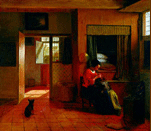










35.
Examining Books by and about Women
in 16th- and 17th-Century Italy and France
in the Context of the History of the Book
Organizers:
Description:
The workshop presents an interdisciplinary approach, which combines the fields
of the history of the book and literary criticism, to the study of early modern
texts. It aims to show how the specialized knowledge of print culture in France
and Italy and the selection of appropriate reading materials can be used in
a course on work by and about women. The workshop applies best to teaching
in advanced courses in literature and in the graduate seminar and offers suggestions
ranging from team teaching with an instructor specialized in book science
and an interdisciplinary degree combining literary studies and the history
of the book.
Laila Paris (10 minutes) Laila Paris will bring to the workshop
slides and photocopies of old and rare books by 17th century women writers
in French and Italian. She will suggest ways to enrich the understanding of
a given text by paying due attention to the physical appearance of the book
and its printing history. Brian Richardson best expresses her approach to
the old and rare book and its text: “Historians of the book are alert
to the danger of divorcing books from their intellectual contexts, of allowing–to
use a phrase of Roger Chartier’s in The Order of Books–their
subject to become a history with neither readers nor authors.” And also,
“A book is not just a ‘content,’ but also an ‘object,’
to be manufactured and traded alongside other commodities.” (Printing,
Writers and Readers in Renaissance Italy, p. x) For all women writing
in the 17th century, the “querelle des femmes” was a “cultural
reality” and a “rhetorical condition” in the terms used
by F. Gray. The vignettes that the printer used as the ornaments for his books,
and books by women acquiring the significance of erotic objects in 19th century
France recall, in their own way the querelle.
Material aspects of the book and printing history: format, binding, the printed
page. Paratexts: title page, illustrations, manuscript notes, marks of ownership,
privilege, preliminary texts. Editions, censorship, the circulation of books.
In this context, the following books will be discussed:
Joyce Miller (10 minutes). A Case Study. Alessandro Piccolomini’s Dialogo della bella Creanza delle Donne (Venice, 1539) and its French translation Instruction pour les jeunes Dames (Paris, 1572 ), shows how the material form of the book determines its audience and the way a text is read. The translation, which was reprinted, under different titles and in various formats, seven times between 1572 and 1630, has been variously interpreted: as a serious conduct book, a satire of courtesy literature, an erotic piece and, most notably by a modern feminist critic, a manifesto for women’s sexual freedom. Floyd Gray argues that feminist readings of early modern works are often anachronistic, because they consider them in the ideological context of contemporary feminism rather than in the context of the cultural reality in which they were written, and points out that the cultural context of the works is due partially to the realities of the printing trade. The examination of the presentation of the text of Instruction--titles, formats and paratexts–of the four independent editions and the three composite volumes in which it appears indicates how the dialogue was read in the sixteenth and seventeenth centuries and how printing practices influenced its reception.
The remaining time will be devoted to questions relating to
the presentation, preliminary readings and questions about teaching and the
curriculum:
1. What is your reaction to Floyd Gray’s assertion that the reading
of early modern works should include a consideration of print culture? Should
a consideration of print culture be included in teaching a literature course?
2. What teaching programs are represented by participants in the workshops?
3. Have you adopted aspects of book science and print culture to the reading
of literature? If so, do you make use of the Rare Book collections? What bibliographical
references do you use, for example, to identify and date editions?
4. What concrete possibilities exist at your institution for some form of
training in book science? If none, how can individual initiatives be implemented?
Preliminary Readings:
|
|
|
||||||
|
|
 |
 |
|
||||
 |
|
 |
|
||||
|
|
|
||||||
|
|
|
||||||
 |
|
||||||
|
|
|
||||||
| |
|
||||||
 |
|
||||||
 |
|
||||||
 |
|
||||||
 |
|
||||||
|
|
|
||||||
|
|
 |
|
|
||||
 |
|
||||||
|
|
|
|
|
|
|
|
|